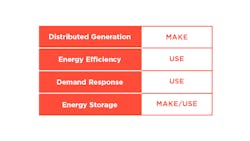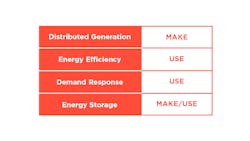Challenges in Implementing Non-Wires Alternatives
Non-wires alternatives (NWAs) are a hot topic in discussions about the future of the power system. NWAs are unconventional solutions that alter load rather than alter the power delivery system through various physical upgrades to wires, substations, transformers, or other assets. The conventional, load-following approach is a tried-and-true method of system improvement, but today other alternatives may be worth considering.
As discussed in the first article on an approach to evaluate NWAs, we will frame NWAs using the MAKE and USE elements of IEEE PES supply-following model. Using NWAs, we can make electricity and we can use, or influence use of, electricity.
NWAs are simply:
These tools can add value and new dimensions to conventional distribution planning approaches. However, it is important to clearly establish goals, objectives, and motivations for NWA implementation.
The current practice of distribution planning involves altering the delivery system to adapt to issues like low voltage, reliability, or undercapacity. These solutions are typically remedied by adding line assets or rebuilding sections of the distribution feeder. However, these solutions may not always be the most cost-effective or quickest way to solve the problem. NWAs can add value by mitigating the risk of large infrastructure becoming stranded or underused while still solving the problem. As noted in our first article, conventional system improvements create risk of being back in the same position within a few short years, again rightsizing assets.
The main challenge for NWAs is incorporating them as part of the conventional planning practice.
The problems NWAs solve are not necessarily unique but the drivers for the change can be. This can lead to a tendency to develop unique programs throughout the system as NWA-compatible projects are identified.
This development can become problematic for the utility. Having unique NWA solutions for every issue on each distribution feeder creates bloated and dissonant programs to maintain throughout the system. A method for selecting the appropriate NWA solution from a standardized toolkit of solutions needs to be incorporated into the utility’s planning practices and this can be addressed by looking at the drivers for the changes — i.e., focusing on the cause, not the effects. This will mitigate complexity in operations as well as maintain the solutions long term.
For example, consider an NWA program involving the creation of a menu of battery sizes and types for distribution planners that can be incorporated into the planning process. Engineering standards and design orders would be concise and help prevent the decision paralysis that could occur when too many options are available. Having compatible units available will minimize the additional complexity of adding NWAs to a planning process.
Another main concern of NWAs is that not all solutions are predictable. There will inevitably be uncertainty over voluntary participation in demand response or behind-the-meter energy efficiency programs. The variables extend from time of implementation on into the future as consumers opt in or out of programs. ISO 31000 defines risk as the impact of uncertainty on objectives. By focusing on causes rather than effects, we can reduce uncertainty, thus providing a reduction in risk. An important component of an NWA toolkit is a robust method of predictive analytics to forecast uncertainties such as adoption rates and effectiveness. Having these tools established in the development of a system-agnostic NWA program allows evaluation to be easily incorporated in the planning process.
For example, a distribution feeder with existing hosting capacity issues may not get the customer participation required to remedy a given problem within a short time period. Although implementing a proactive demand response program can help, it still creates a risk of having to implement a conventional wires solution along with the NWA solution. Given adequate time and targeted awareness to consumers on that distribution feeder, the demand response program will hopefully mitigate the need for a rebuild that would provide the ampacity needed only a handful of days each year. This excessive capital expenditure could be mitigated, at least in part, by NWA, thus freeing headspace in the capital budget for other projects.
Utilities should develop NWA programs by coming up with an approach for incorporating them into their distribution planning strategy. This consists of evaluating technologies and methods suitable to a service territory and organization, development of an NWA toolkit, and subsequent development of criteria to qualify projects for program implementation.
Typically, NWAs will qualify for implementation when cost-benefit analysis shows these are optimal over conventional methods, including a quantified measurement of relative risk under each approach.
Conventional approaches, on the other hand, can still be the optimal choice. When cost-benefit analysis determines that a rebuild or conventional approach is the best path forward, overbuilding may be an acceptable risk. This would mean rebuilding with extra hosting capacity for plenty of flexibility. With expected lifetimes of 40 or more years, the marginal costs of installing larger conductor and sturdier poles will often outweigh the risk of load growth requiring another rebuild or excessive load management program. The way the power system will look in a few decades is difficult to predict, so build it to be as flexible and robust (resilient) as possible.
Distribution planning deals with many unknowns about the future state of the grid. Fortunately, this is where supply following methods draw their strength. Utilities must increasingly consider steps to allow MAKE and USE energy solutions, or otherwise improve the flexibility of the grid to accommodate the full scope of these unknowns. In our next article, we’ll look at characteristics of an NWA engine — both from the standpoint of what it looks like and how to evaluate alternatives within the NWA framework.
About the Author
Jackson Cutsor
Jackson Cutsor is an analyst for power distribution systems in the Business & Technology Solutions Group at Burns & McDonnell. His expertise includes sustainable energy and electric transportation, grid modernization, renewable energy, batteries, and electric vehicles.
Daniel Ernstmann
Daniel Ernstmann is a lead analyst at Burns & McDonnells, providing process improvement solutions to clients.
Lucas McIntosh
Lucas McIntosh, PE, LEED AP, is managing director of advisory consulting at 1898 & Co., part of Burns & McDonnell.
Mark Knight
Mark Knight is a principal consultant for the energy and utility industries at 1898 & Co., part of Burns & McDonnell. With more than 30 years of experience working for utility companies in the U.K. and the U.S. and as a consultant in the electric supply industry, he is focused on building comprehensive strategies that will improve business and technology solutions for clients. Mark is chairman emeritus of the GridWise Architecture Council and a member of the Institute of Asset Management (IAM). He has participated in several IAM teams to develop asset management guidelines.



